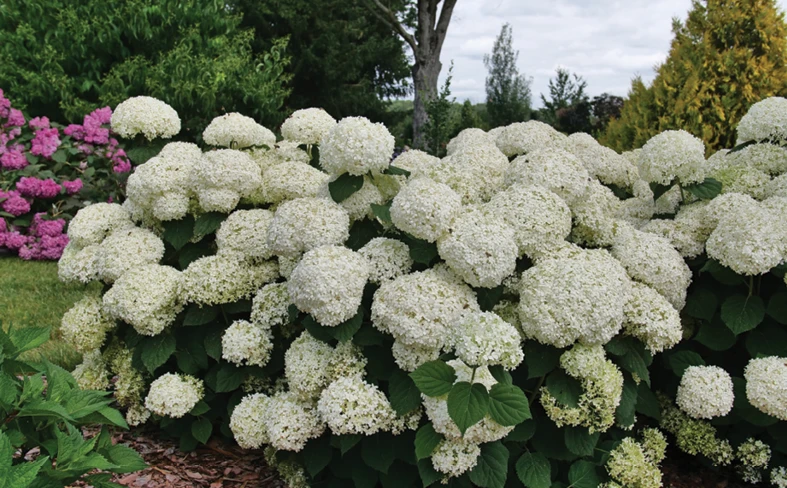Herbicides are not miracle workers. They are not forgiving. They must be used properly for them to work correctly. Follow these suggestions for timing and application for a more successful fight against weeds in the field.
Examples of common nursery pre-emergence herbicides labeled for grass are Surflan, Pennant, Pendulum and Barricade (formerly Factor). Some pre-emergence herbicides labeled for broadleaf weeds include Simazine (Princep), Gallery and SureGuard.
For best all around control, one of the grass herbicides must be tank-mixed with one that prevents broadleaf weeds. There are other pre-emergence herbicides; Casoron, Dacthal, Devrinol, Goal, Kerb and Treflan labeled for nursery stock, but used less often and then for a particular crop or weed.
Activation
A half-inch of irrigation or rain or a 1- 2-inch shallow cultivation is required within 7-30 days to activate most pre-emergence herbicides; to turn them on, so to speak. This is why they don't work as well when applied in the summer. They may never get turned on if rain does not fall and drip irrigation will not activate pre-emergence herbicides.
 Run the hose from the tank to the bumper across a rear fender and install a 1/4 turn ball valve. This prevents the driver from having to turn around in a straining reach, to turn the valve off or on while also attempting to throttle down and turn around at the end of the row. |
It could be easy to lose the pre-emergence effect if cultivated too deep. The herbicides need to be mixed into the top 1-2 inches, but mixing them into the top 4 inches would dilute the active ingredient to the point of being useless.
Pre-emergence herbicide weed control usually lasts about 90 days during the growing season, when labeled rates are followed. This can vary with the herbicide, rate, soil type and rainfall. Excessive rainfall can reduce the period of weed control.
Two to three applications will be required per year for good weed control. However, with Gallery and SureGuard, broadleaf weed control may last five months. It is not good to use the same chemistry over and over, year after year.
With SureGuard, it is safest to apply it to one-year-old and older spaced tree transplants with no green bark. It is strong on broadleaf weeds, but grass germination may occur before broadleaf weeds germinate.
You may get year-round control with two applications, but need to apply postemergence grass herbicides in the summer, especially during rainy years.
Also, SureGuard has been weak on sicklepod and bullnettle. Avoid over-the-top applications with most plants – if in doubt, check the label or treat a few plants to observe phytotoxicity. There aren't as many precautions with Princep and Surflan.
Timing
Feb. 1 to March 15 is an excellent time to apply pre-emergence herbicides since there is a very good chance of rainfall for activation. A midsummer application may not get activated if it does not rain within the required period.
The fall (Sept-Dec) is a good time to spray Simazine (Princep), Gallery or SureGuard to prevent the germination of winter annuals. This application will suppress weed germination into the spring, which will buy time for other important tasks. This may be the most important application of the year. Apply 1½ quarts Princep, 0.75-1 pounds Gallery or 10 ounces SureGuard per sprayed acre. Add Barricade, Pendulum, Pennant or Surflan in the blocks that have a spring ryegrass problem.
Keep in mind: Spraying over swelling buds with a tank mix of Surflan + Princep has occasionally stunted growth in young plants but Pendulum has taken out the central bud and culled first year dogwood buds. First-year pear buds have been deformed and stunted, but they usually grow out of it.
Application
It's always best to spray clean, freshly cultivated and hoed soil with no existing weeds, regardless of the time of year. Pre-emergence herbicides do not kill green vegetation. A typical protocol is to make a postemergence herbicide application with glyphosate (Roundup) or glufosinate (Finale) using an Enviromist sprayer two weeks after applying the pre-emergence herbicide to kill any escapes.
 This tractor carries a spray arm mounted on the front bumper, with a single nozzle to band herbicides. It allows horizontal and vertical adjustment. This tractor carries a spray arm mounted on the front bumper, with a single nozzle to band herbicides. It allows horizontal and vertical adjustment. |
During the growing season, it is imperative to spray the pre-emergence herbicide the same day or no later than the next day once the grass and weeds are removed. If not, the grass and weed seed that germinate daily will not be controlled by the pre-emergence herbicide. Seed will germinate several days before emerging out of the ground and be visible. The soil could appear clean. SureGuard offers some burn down on weeds less than two inches. A major reason for herbicide failure is a lack of rain within the required time to activate the pre-emergence herbicide sprayed.
Don't spray transplants until after a good settling rain. Apply pre-emergence herbicides in 20-40 gallons of water per acre, or according to the label. Pressures around 30 psi are adequate when spraying bare ground or short grass. Higher pressures create finer particles that a breeze can easily blow away. Tall vegetation may require 60 psi.
Band spraying is a preferred way to apply herbicides to nursery stock rows. While broadcast spraying is faster, there is no need to spray middles that can be mowed or will be cultivated later. In fact, vegetation in the middles is not harmful to the nursery crop, as long as a sufficiently wide weed-free strip is maintained in the row. Vegetated middles reduce erosion on slopes. Banding reduces the amount of chemical required by one-third to one-half but does require more labor and machinery costs to drive down each side of the row.
Cultivation or herbicides can be used to maintain a weed-free strip 12-18 inches wide on each side of the planted row during the first year. The strip can be widened each year to a maximum of 2-3 feet on each side of the row.
Rigging to band spray
It is possible to rig a nozzle on the rear of the spray tank to spray toward the base of the plants in the row, but it can't be watched as easily as one mounted on the front. Most operators prefer mounting a spray arm with a single nozzle on the front bumper of a small tractor, with a 50-gallon PTO spray tank mounted on the 3-point hitch. This eliminates the wiggle created when the front of the tractor makes a slight maneuver.
A 3- 4-foot length of 1¼-inch square metal tubing can be mounted horizontally on the front bumper to hold another 18 inch length of 1-inch tubing that can be slid inside to achieve horizontal adjustment. Drill and weld a nut with a bolt to tighten it in place. Perforated metal tubing available at hardware stores will also provide horizontal adjustment but vertical adjustment must be achieved by the mount.
The 3-foot tube can be slid through the weight handles of some tractors. It can be secured with multiple zip ties or bolted on. The 3-foot tube could be permanent but the piece that slides inside and all hoses could be easily removed for storage.
Attach a nozzle on the end of the 1-inch tube. Run a reinforced spray hose (not anhydrous ammonia hose) to the nozzle from the tank, perhaps under the tractor, avoiding hot areas that will melt the hose. Zip ties are great and allow the hose to be suspended in places.
Band spray suggestions
A great idea to reduce driver fatigue and increase safety is to run the hose across the right rear fender (for right handed operators). Cut the hose and install a ¼-turn ball valve. (Add a second hose and valve if spraying both sides.) This prevents the driver from having to turn around in a straining reach to turn the valve off or on while also attempting to throttle down and turn around, while not running over the end plants.
 A pre-emergence herbicide was banded in this block of red maples after a postemergence herbicide was applied with the Enviromist sprayer to kill existing vegetation. The Enviromist can be used with Roundup or Finale to kill escaped weeds A pre-emergence herbicide was banded in this block of red maples after a postemergence herbicide was applied with the Enviromist sprayer to kill existing vegetation. The Enviromist can be used with Roundup or Finale to kill escaped weeds |
Always allow extra hose so the nozzle on the slide bar can be adjusted to its widest point. Leaving a little extra will be handy for repairs. Hoses can't make 90 degree turns without collapsing.
Brass nozzle bodies should be more durable than nylon. A worn nozzle can affect output, so check the sprayer output annually. A good quality plumber's paste is easier to use than Teflon tape to stop leaks and it remains pliable. Always keep spare parts of each item that could stop progress in the field; especially pressure gauges, pressure regulating valves, nozzle body strainers, pump, etc.
Vertical adjustment can be provided with a few more minutes of welding. Vertical adjustment controls the band width. Unlike on a boom, a single nozzle can be carried at any height to achieve the width desired.
Another spray arm and nozzle can be mounted on the other side of the front bumper using the same 3- 4-foot 1¼-inch tube. Two inside strips, (a strip on one side of two rows), can be sprayed at the same time and will cut the trips in half. This works if the rows are not too wide. So what if the rows are not perfectly straight? Satisfactory weed control will still be achieved by the 18- 24-inch band sprayed on each side.
Spray tips
It used to be common to find rigs applying 50 gallons of water per acre with 8004 tips, due to the slow tractor speed. Changing the tip size to 8002 cut the water in half, but produced a finer spray that was more difficult for the driver to see and easier for the wind to move.
I prefer 25 gal/acre of water for convenience and because most rigs have a 50-gallon tank. An 8003 tip is a compromise for some operators.
Standard flat fan spray tips require a minimum of 30 psi to develop a full pattern. A TeeJet XR (Extended Range) tip will develop a full pattern at 15 psi. Both will operate up to 60 psi. The VisiFlo tip is color coded for output and convenience. The code on an 8004 tip might read XR8004VS. These tips have a stainless steel center for extended wear and the rest is colored nylon.
An off-center (OC) tip reaches out further and is useful in some applications. An OC-02 will apply the same volume as a TeeJet 8002. An off-center tip is available in most sizes. Brass off-center tips cost about $8.50 compared to $3.50 for regular flat fan tips.
Sprayer calibration
Preemergence herbicide labels recommend a sufficient water volume to obtain uniform coverage. Individual herbicides require different amounts of water to achieve maximum weed control. Some may suggest 20 gallons per acre, while others may state a range of 20-100 gallons per acre. Any more than the recommended spray volume merely wastes time to fill the tank up more often. This can be significant if the tractor has to be driven a long distance to a water source.
It is possible to apply 10 to well over 100 gallons of water per acre. It is essential to know the number of gallons sprayed per acre in order to know how much pesticide to add to the tank. Calibration is the process of modifying or adjusting a sprayer to give the desired application rate with uniform coverage.
Author note: This article is intended to provide general information about the use of herbicides in nursery settings. The mentioning of product names is merely for informational purposes and is not intended to endorse or discourage the use of any product. This list of products may not be comprehensive and other products may exist. This information is not intended to supersede or replace the label. Always refer to a current label before making the application, which may contain updated or additional information not provided in this article.
Mark Halcomb is the University of Tennessee Extension Area Nursery Specialist in McMinnville, Tenn.; mhalcomb@utk.edu, www.utextension.utk.edu/mtnpi/index.html.
Get curated news on YOUR industry.
Enter your email to receive our newsletters.
Explore the October 2011 Issue
Check out more from this issue and find your next story to read.







